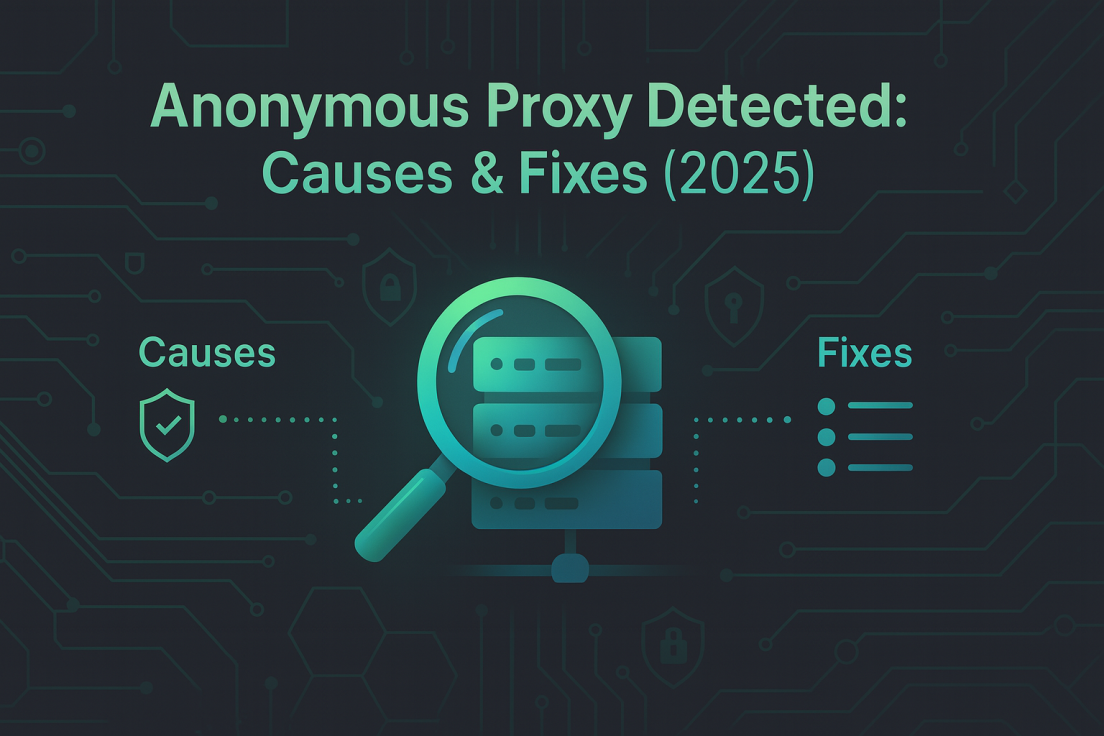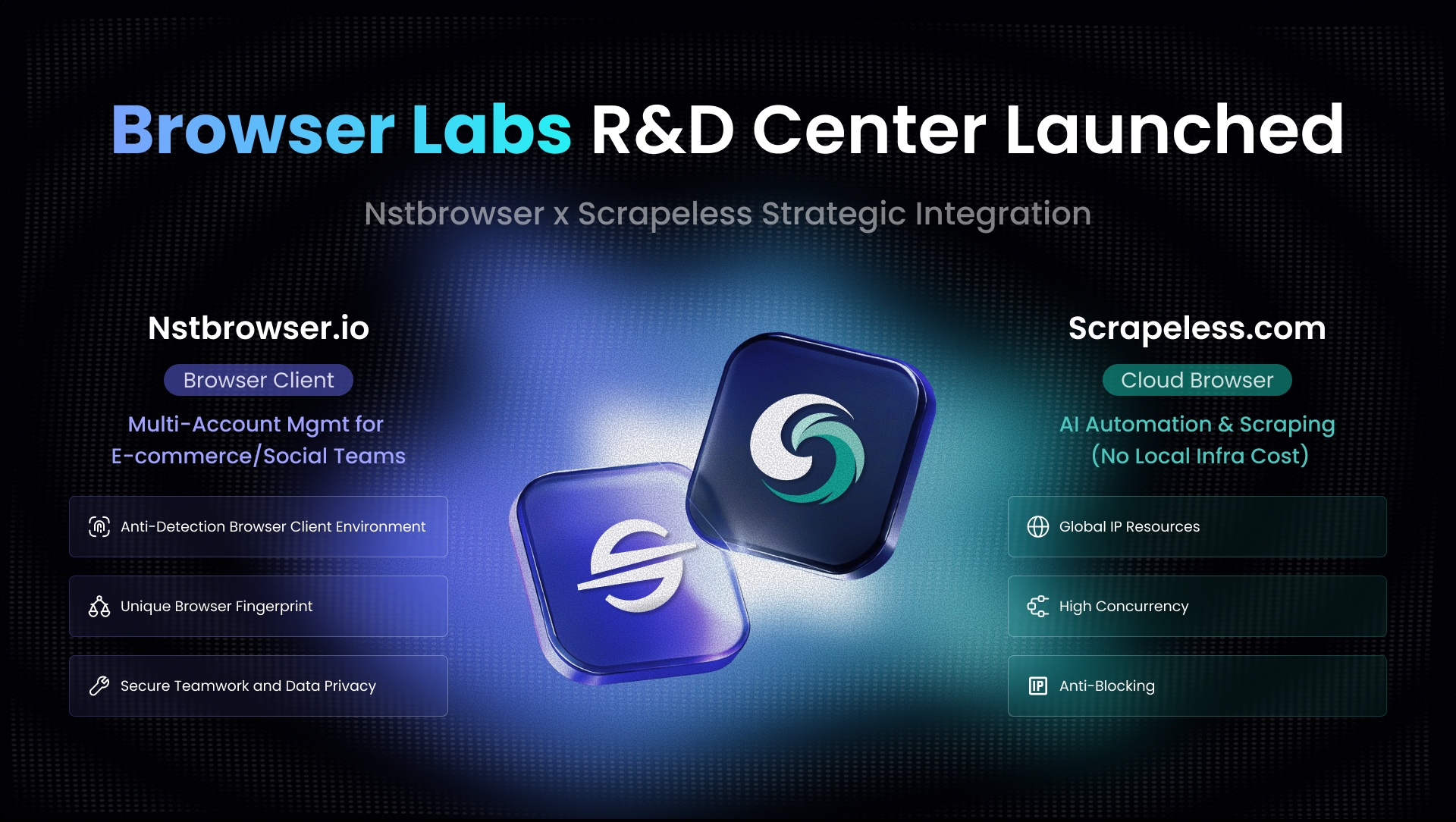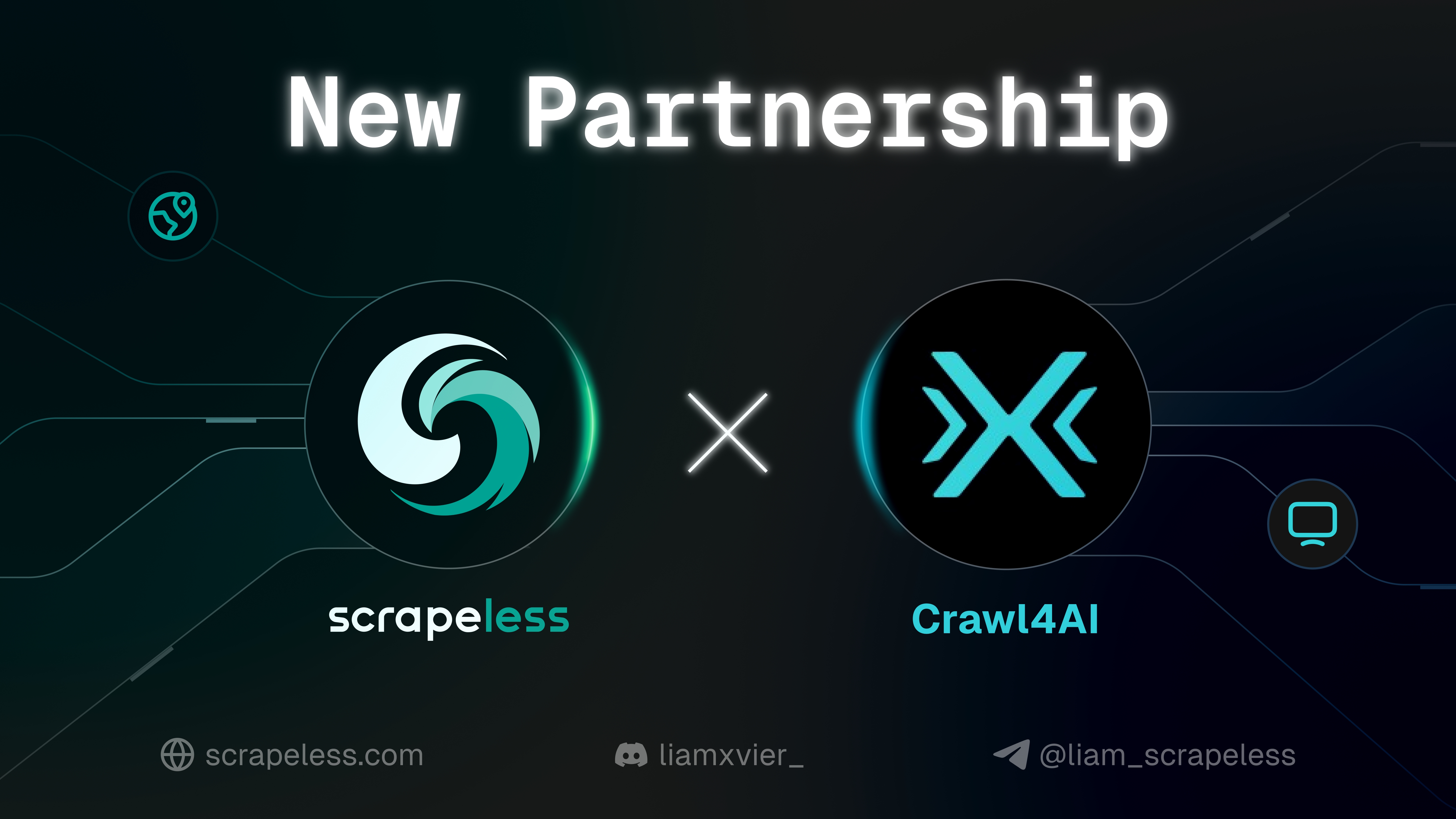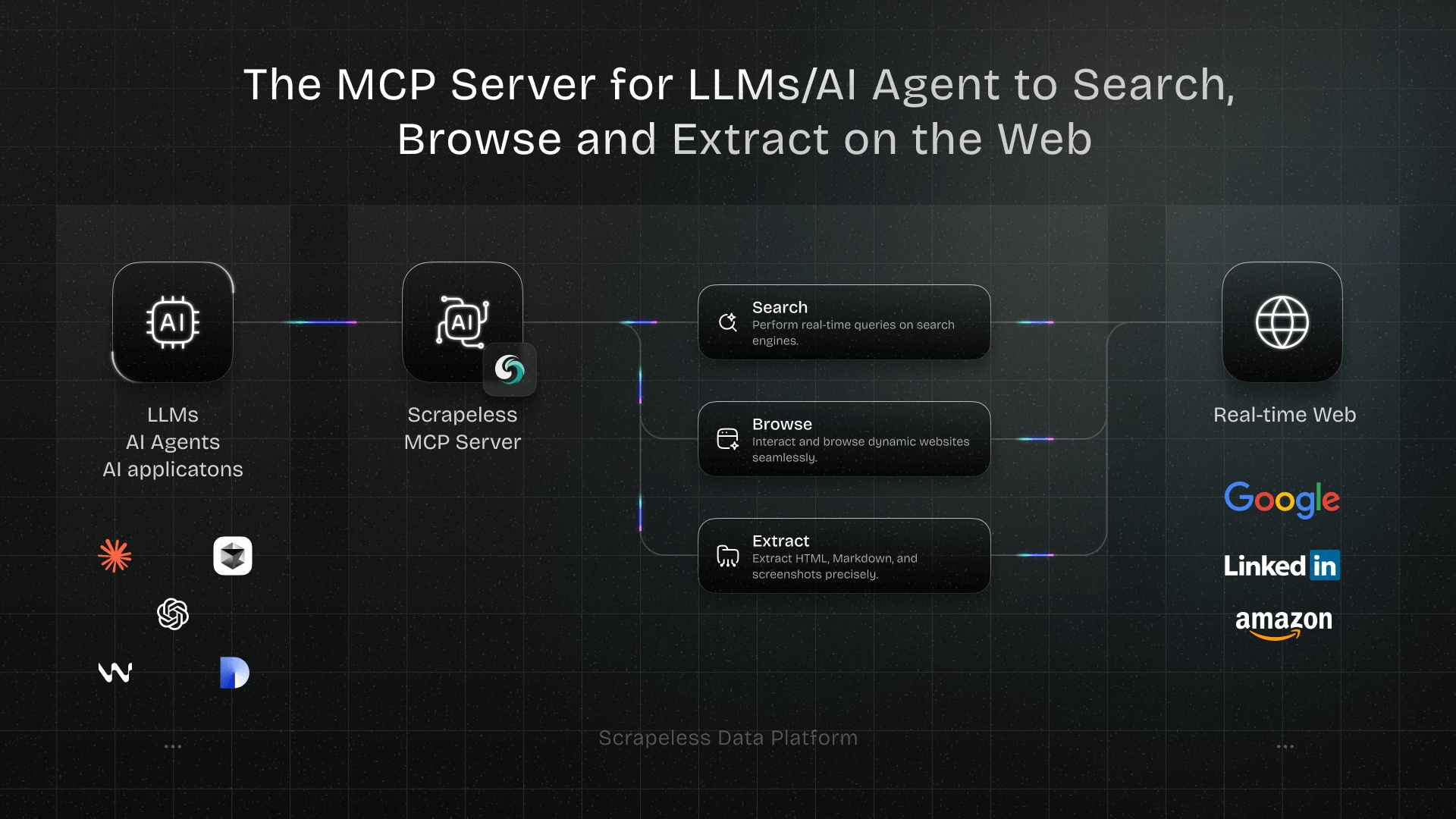Anonymous Proxy Detected: Causes & Fixes (2025) - Scrapeless
Expert Network Defense Engineer
Key Takeaways:
- The "Anonymous Proxy Detected" error signifies that a target server has identified and blocked your proxy connection.
- Common causes include using low-quality proxies, static IPs, high request frequency, and misconfigured proxy settings.
- Websites use IP reputation, behavioral analysis, and HTTP header analysis to detect proxies.
- Effective fixes involve using high-quality residential proxies, implementing IP rotation, clearing browser data, and modifying headers.
- Specialized web scraping APIs like Scrapeless offer comprehensive solutions to bypass sophisticated proxy detection mechanisms.
Introduction
Encountering the "Anonymous Proxy Detected" error can be a significant roadblock in web scraping and online privacy. This message indicates that a target website has identified your connection as originating from a proxy server and subsequently blocked access. This article will delve into why anonymous proxies are detected, the mechanisms websites use for identification, common scenarios leading to this error, and practical fixes to ensure your operations remain undetected in 2025. We will also highlight how advanced solutions like Scrapeless can provide a seamless and effective way to overcome these challenges.
What Is an Anonymous Proxy?
An anonymous proxy acts as an intermediary, masking your real IP address and routing web traffic through a separate IP. This makes it appear as though the request originates from the proxy server, enhancing privacy, bypassing geo-restrictions, or facilitating web scraping. The level of anonymity varies; elite proxies offer the highest, while standard proxies may leave clues in HTTP headers. Transparent proxies offer no anonymity, revealing both the real IP and proxy usage.
How Proxy Detection Works
Websites employ sophisticated techniques to identify and block proxy connections. Understanding these mechanisms is crucial for successful bypass [1].
1. IP Reputation Tracking
Websites maintain databases of known proxy IP addresses. IPs frequently associated with suspicious activities are flagged and blacklisted. Free or low-quality proxies are particularly susceptible due to overuse and poor reputation. Websites cross-reference incoming IPs against these blacklists [2].
2. Behavioral Analysis
Websites analyze user behavior to distinguish humans from bots. Bots exhibit predictable, rapid request patterns. Advanced anti-bot systems use machine learning to detect anomalies. Cloudflare's Bot Management, for instance, identifies residential proxy abuse without blanket IP blocking [3].
3. HTTP Header Analysis
HTTP headers contain metadata about web requests. Proxies can inadvertently leak information through specific headers (e.g., X-Forwarded-For, Via). Websites analyze these for inconsistencies or explicit proxy indicators. If a proxy fails to strip certain headers or adds its own, it can be detected [4].
4. JavaScript and Browser Fingerprinting
Many modern websites use JavaScript for client-side proxy detection. Browser fingerprinting collects unique browser characteristics (plugins, fonts, screen resolution, WebGL data) to create an identifier. If this fingerprint is inconsistent or indicates automation, the connection is flagged [5].
5. CAPTCHAs and Honeypots
CAPTCHAs distinguish humans from bots. Websites trigger them upon suspicious activity. Honeypots are hidden links designed to trap bots; accessing them flags the scraper as malicious [6].
Common Reasons for Anonymous Proxy Detection
Several factors commonly lead to "Anonymous Proxy Detected" errors [7].
1. Using Free or Low-Quality Proxies
Free proxies are unreliable, slow, and quickly blacklisted due to overuse and poor reputation. Investing in reputable, paid proxy services is crucial [8].
2. Static IPs Being Flagged
Using a static IP for frequent requests makes it easy for servers to identify and block it. A static IP lacks the dynamic nature of human browsing [9].
3. High Request Frequency
Bots make requests faster and more consistently than humans. Too many requests in a short period trigger rate limits and behavioral detection [10].
4. Leaking Real IP Due to Misconfigured Proxy Settings
Improper proxy configuration can inadvertently reveal your real IP, defeating the proxy's purpose. Misconfigurations include incorrect setup, failure to strip identifying headers, or DNS leaks [11].
5. Inconsistent Browser Fingerprints
Headless browsers or automation tools with inconsistent or easily identifiable browser fingerprints lead to detection. Static or generic attributes, or automation indicators, flag connections as non-human [12].
6. Lack of Proper HTTP Headers and User-Agent Rotation
Minimal or inconsistent HTTP headers, or a static User-Agent, make a scraper stand out. Websites expect diverse, realistic headers mimicking actual browser traffic [13].
7. Failure to Handle CAPTCHAs and JavaScript Challenges
If a scraper cannot solve CAPTCHAs or execute complex JavaScript, it will be blocked, especially on dynamic websites [14].
How to Fix the Anonymous Proxy Detection Error
Overcoming detection requires a multi-pronged approach [15].
1. Use High-Quality Residential Proxies
Residential proxies appear as legitimate user traffic, making them harder to detect than datacenter proxies. Investing in premium residential proxies is essential [16].
2. Implement Intelligent IP Rotation
Cycle through a large pool of diverse IP addresses for each request. Advanced proxy services offer automatic IP rotation, mimicking multiple distinct users [17].
3. Clear Cookies and Browser Cache Regularly
Regularly clear cookies and cache between requests to simulate a fresh user, resetting tracking mechanisms [18].
4. Modify Headers and User-Agent Dynamically
Send a comprehensive and realistic set of HTTP headers. Dynamically rotate User-Agent strings to mimic different browsers and devices. Ensure other headers like Accept and Referer are consistent and varied [19].
5. Mimic Human Behavior and Introduce Random Delays
Introduce random delays between requests (time.sleep(random.uniform(min_delay, max_delay))). Simulate human-like interactions like mouse movements and scrolls. Avoid predictable navigation patterns [20].
6. Use Headless Browsers with Stealth Techniques
For JavaScript-heavy websites, use headless browsers with stealth techniques. Disable automation flags, modify browser properties, and inject JavaScript to mimic human interaction, bypassing browser fingerprinting [21].
7. Integrate with CAPTCHA Solving Services
Integrate with third-party CAPTCHA solving services or specialized web scraping APIs with built-in CAPTCHA bypass [22].
8. Implement Retries with Exponential Backoff
When a request fails, implement a retry mechanism with exponential backoff, waiting for progressively longer periods between retries. This reduces server load and increases success chances [23].
9. Utilize Web Unlocking APIs
For challenging websites, a specialized Web Unlocking API (like Scrapeless) is often the most reliable solution. These APIs handle all anti-detection aspects automatically, including smart proxy rotation, advanced browser fingerprinting, JavaScript rendering, and CAPTCHA solving [24].
Comparison Summary: Proxy Types and Detection Likelihood
| Proxy Type | Anonymity Level | Detection Likelihood | Best Use Cases | Pros | Cons |
|---|---|---|---|---|---|
| Transparent Proxy | None | Very High | Internal network filtering | Easy to set up, low cost | No anonymity, easily detected, leaks real IP |
| Anonymous Proxy | Moderate | High | Basic geo-unblocking, simple scraping | Masks IP address | Can be detected by HTTP headers, often blacklisted |
| Elite Proxy | High | Moderate | General web browsing, some scraping | Masks IP, hides proxy usage | Still detectable by advanced methods, often static IPs |
| Datacenter Proxy | High | Moderate to High | High-speed data transfer, non-sensitive scraping | Fast, affordable, high bandwidth | Easily detected by IP reputation, not residential IPs |
| Residential Proxy | Very High | Low | Web scraping, ad verification, market research | Appears as real user, high anonymity, hard to detect | More expensive, can be slower than datacenter proxies |
| Mobile Proxy | Very High | Very Low | Highly sensitive scraping, social media management | Uses real mobile IPs, extremely hard to detect, high trust score | Most expensive, limited bandwidth, fewer IPs |
| Web Unlocking API | Very High | Very Low | Large-scale web scraping, complex anti-bot sites | Handles all anti-detection automatically, high success rate | Requires external service, cost scales with usage |
Why Scrapeless is Your Best Alternative
Implementing all these strategies manually requires significant effort and constant adaptation. Scrapeless integrates these best practices into a single, easy-to-use API. It acts as an intelligent layer, orchestrating advanced techniques for high success rates. Scrapeless offers:
- Smart Proxy Management and Rotation: Vast pool of high-quality residential and mobile proxies, automatically rotated.
- Advanced Browser Fingerprinting and Stealth: Dynamic User-Agent rotation, consistent HTTP header management, and fingerprinting evasion.
- Full JavaScript Rendering: Handles dynamic websites, ensuring all content is available.
- Automated CAPTCHA Solving: Integrates CAPTCHA solving for uninterrupted scraping.
- Human-like Behavior Simulation: Simulates human browsing patterns and random delays.
- Continuous Adaptation: Continuously updated to counter new anti-bot techniques.
By leveraging Scrapeless, you offload the burden of managing complex anti-detection infrastructure, focusing on data analysis. It provides superior success rates, scalability, and cost-effectiveness compared to self-built solutions.
Conclusion
The "Anonymous Proxy Detected" error is a common challenge. Successfully avoiding detection requires a strategic combination of high-quality proxies, intelligent IP rotation, dynamic header management, human-like behavior simulation, and robust JavaScript rendering. emerges as a leading alternative, consolidating these advanced anti-detection strategies into a single, managed API. It empowers developers and businesses to overcome the challenges of web scraping, ensuring high success rates and allowing them to focus on extracting valuable insights from web data.
Ready to overcome proxy detection and enhance your web scraping success?
Discover Scrapeless today and experience seamless, reliable web data extraction. Visit our website to learn more and start your free trial!
Start Your Free Trial with Scrapeless Now!
Frequently Asked Questions (FAQ)
Q1: What is the primary reason for "Anonymous Proxy Detected" errors?
The primary reason is often the use of low-quality or free proxies that have poor IP reputations and are easily blacklisted by websites. High request frequency, static IP usage, and misconfigured proxy settings also contribute significantly.
Q2: Can VPNs also trigger "Anonymous Proxy Detected" errors?
Yes, VPNs can also trigger these errors. Websites often maintain databases of known VPN IP ranges and may block connections originating from them, especially if they are associated with high-volume or suspicious activity. Some advanced anti-bot systems can even detect VPN usage through behavioral analysis or browser fingerprinting.
Q3: How can I test if my proxy is truly anonymous and undetected?
You can test your proxy by visiting websites specifically designed to detect proxy usage or reveal your true IP address (e.g., whatismyipaddress.com). Additionally, you can inspect HTTP headers sent by your client to ensure no identifying information is being leaked. Tools like browserleaks.com can also help check for browser fingerprinting vulnerabilities.
Q4: Is it legal to use proxies for web scraping?
The legality of using proxies for web scraping is complex and depends on several factors, including the website's terms of service, the type of data being scraped, and the jurisdiction. While using proxies to access publicly available information is generally not illegal, bypassing security measures or scraping copyrighted/personal data without consent can lead to legal issues. Always consult legal advice for specific use cases.
Q5: How does Scrapeless help avoid anonymous proxy detection?
Scrapeless integrates a comprehensive suite of anti-detection features, including smart proxy rotation (residential and mobile IPs), advanced browser fingerprinting evasion, full JavaScript rendering, automated CAPTCHA solving, and human-like behavior simulation. It continuously updates its infrastructure to adapt to new anti-bot techniques, providing a high success rate for web scraping without manual intervention.
At Scrapeless, we only access publicly available data while strictly complying with applicable laws, regulations, and website privacy policies. The content in this blog is for demonstration purposes only and does not involve any illegal or infringing activities. We make no guarantees and disclaim all liability for the use of information from this blog or third-party links. Before engaging in any scraping activities, consult your legal advisor and review the target website's terms of service or obtain the necessary permissions.



